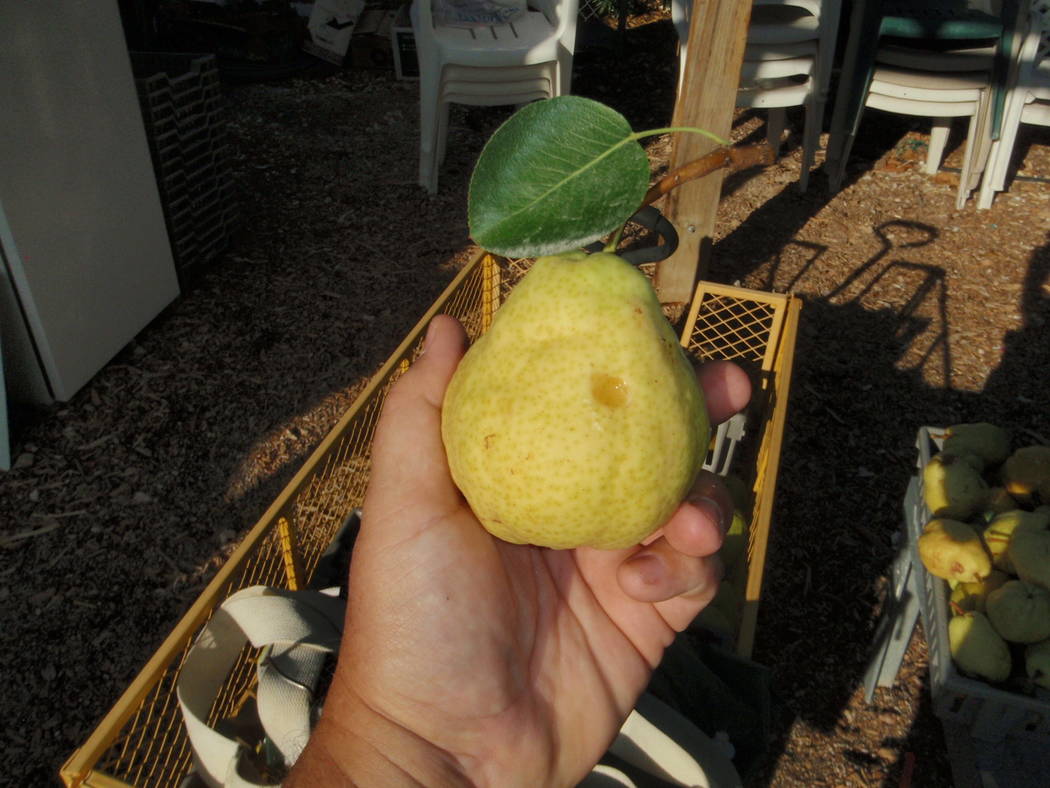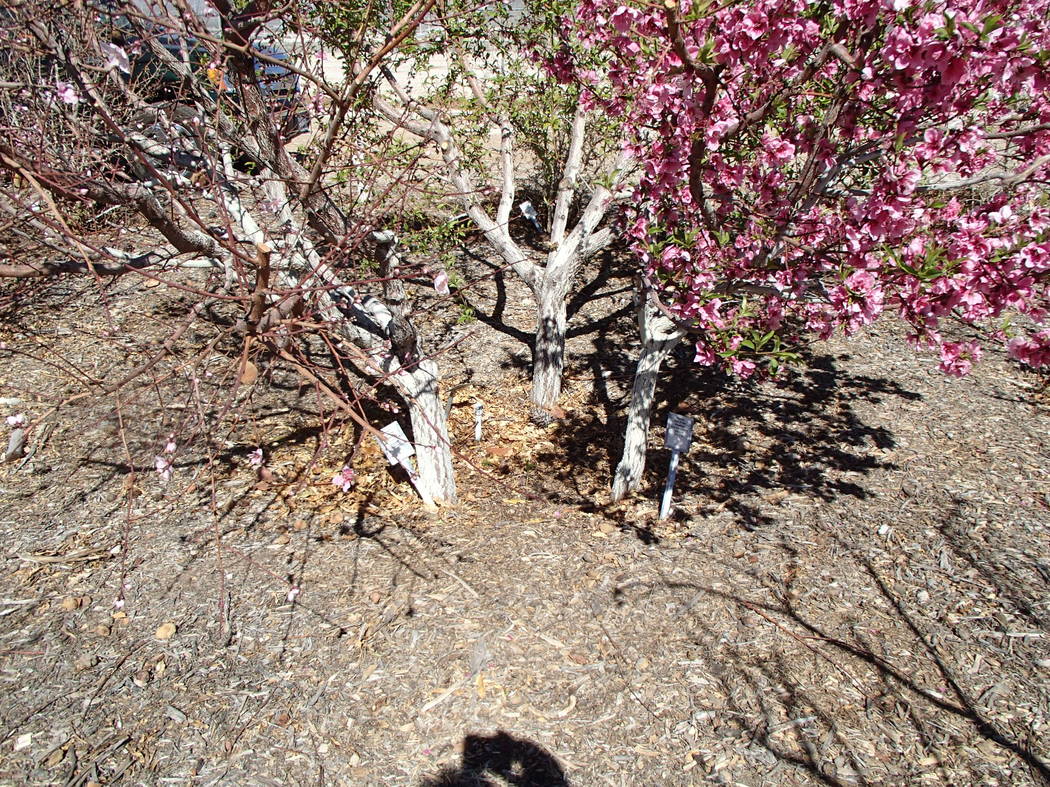Planting two trees in one hole only for experienced gardeners
Q: I live in North Las Vegas and want to plant both a red Bartlett and a Keiffer pear but have limited space. I read about planting two trees in one larger hole. Do you recommend this method?
A: This technique, planting multiple trees in a single planting hole, requires a higher degree of maintenance and knowledge to do it correctly than planting them separately. It is not easy, and I would not recommend it unless you are an experienced gardener, particularly in growing fruit trees.
The usual reason for growing multiple fruit trees very close to each other is for sequential harvest of fruit — harvesting fruit at different times of the year, rather than all at once. The most common fruit trees used for this are peaches, plums, pluots and apples.
In the shared hole (trees planted 18 to 24 inches apart), two to four fruit trees of the same general type are planted together. For instance, an early, mid and late peach (three trees) might be planted together. Or an early, mid and late plum. I have knowingly violated this rule, but it is best not to.
The reasoning behind this technique is that smaller amounts of fruit are produced at different times of the year, so an entire crop from a full-sized tree doesn’t all come in at the same time.
Planting a Keifer and red Bartlett pear in the same hole gives you two pears that produce fruit close to the same time of year. But it does, however, give you two pears used for very different purposes, so it might work if you like both fruits.
Red Bartlett and Kiefer pears are very different from each other. A Kiefer pear is not a dessert pear, whereas a Bartlett is. A Keifer is more of a cooking or salad pear. It tastes closer and is very firm, more like a jicama, than a Bartlett pear.
A red Bartlett pear tastes like a Bartlett pear, a dessert pear, but has red skin on the outside, instead of a green skin that turns yellow when ripe. In my opinion, the red Bartlett is a very pretty pear but requires a bit more care than a Keifer to grow.
Whichever pear you decide to grow, or both if you want to experiment with multiple trees planted in a single hole, it requires soil preparation with compost at planting time. I would highly recommend covering the soil with wood chips about 4 inches deep after you’ve finished planting.
Q: We have a 200-square-foot lawn (20 by 10) that turned brown because I think it got too much water. When we first put down the sod, I don’t know if we had a good soil base under it. How many inches of soil do we need to give new sod a good start?
A: Fall is the best time to install a new lawn, between Oct. 1 and about the middle of November, longer if the weather is still good. But please remember, a good lawn can’t survive in the desert without a good irrigation system. Make sure your irrigation system was designed and installed correctly.
Soil preparation before planting seed or sod is important before establishing a lawn, but it is possible to establish a lawn on poor soils and improve it later. I don’t recommend doing this, but it’s possible.
Part of the problem when laying new sod on top of desert soil is the layer, or interface, created where the bottom of the sod meets the top of the soil. This interface frequently creates drainage problems in contact with unimproved desert soils.
Poor drainage increases disease problems. Many homes in subdivisions have horrible soils created by developers and need improvement to be successful.
If the soil beneath the sod was not improved prior to laying it, water will “perch” or move very slowly into the unimproved soil beneath it. If the lawn area is not perfectly level, this perched water drains horizontally to low spots in a lawn. These low spots with poor drainage create the ideal environment for diseases during warm and hot weather.
If sod is laid on top of soil with poor drainage, the lawn area must be punched with holes so that water moves from this perched layer into the soil beneath it. This is done with devices called aerifiers and should be done within a couple of weeks after planting.
The most effective aerifiers are core aerifiers. Core aerifiers remove soil plugs when operated. Some aerifiers are operated manually and used for small lawns. Some are powered by gasoline engines, resemble a lawn mower and are rented for large lawns.
Ideally, the soil base under a lawn should be 12 inches deep. You could squeak by with a 6-inch soil base, but 12 inches would be ideal. Either bring in a manufactured soil for this purpose or create your own with compost, a rototiller and a drum roller.
If you elect to create your own soil base, apply 2 to 3 inches of 100 percent compost to the top of the soil and rototill as deep as possible. After rototilling, the soil must be firmed before laying the sod or seeding. Don’t forget to apply a starter fertilizer before planting.
If rototilling, the fastest way to firm the soil is to rent a drum roller made of heavy steel or one that is filled with water. Roll it over the loosened soil until the soil is firmed enough so walking causes your shoes to sink no more than 1/2 inch deep. After this you are ready to seed or sod.
Q: I am a relatively new transplant to Las Vegas from the cold part of the country with snow, ice and freezing temperatures. I have roses in my garden here and wondering how to care for them, given there is no real winter.
A: The concept of “no real winter” is a relative concept. In the cold country where I grew up, we claimed four seasons. But it could be argued there are only two for roses: winter, when nothing we can see is happening, and summer, when roses are blooming.
Actually, the Mojave Desert has a longer growing season for roses than snow country. Roses perform nicely for about eight months of the year in the eastern Mojave Desert. Floribundas, climbers, miniatures and even “off-the-wall” roses do well in this climate once you get your feet wet growing the easier ones.
Our real winter is the months of July and August and half the months of June and September. But for the most part, roses perform quite well the rest of the year if you select the right variety, put them in a good location, plant and manage them correctly.
Against a south facing wall, roses do very well during the winter but perform horribly during the heat of the summer. On the east facing side of the landscape with protection from late afternoon sun, the same roses perform well but at different times of the year.
Select a good rose variety. Visit the Weeks Roses website and select rose varieties from this list: www.weeksroses.com/_RoseInfo/climate.html.
Plant them in a good location. The easiest spot will be facing east with protection from mid and late afternoon direct sunlight during the summer. Expand into more difficult areas as your experience with roses increases.
Amend the soil with good quality compost or other high-quality soil amendments at planting time. Do not mulch (cover the soil after planting) with rock. Use mulch that decomposes, such as wood chips, which helps improve the soil over time.
Visit either of the Rose Society meetings in the Las Vegas Valley: the Las Vegas Valley Rose Society or the South Valley Rose Society: www.angelfire.com/nv/lvrosesoc/join.html or www.southvalleyrosesociety.com.
The hot, dry desert climate is a wonderful climate for roses. Remember the Damascus rose!
Bob Morris is a horticulture expert and professor emeritus for the University of Nevada, Las Vegas. Visit his blog at xtremehorticulture.blogspot.com. Send questions to Extremehort@aol.com.
























